Thousands of artifacts have been recovered so far this spring. We have had 25 classes participate in our Experiential Learning Program, giving more than 500 students the opportunity to help discover the history of Block 4 at the Johnson’s Island Prison Compound.
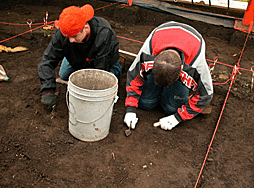
Students excavate Unit B |
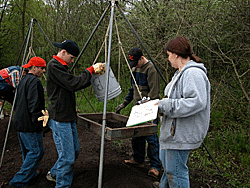
Screening for artifacts |
Our findings have included over 200 Field Specimens (FSs), artifacts that we record separately because they require special care or are of special interest. Students that discover an FS are recorded in our Field Specimen Catalogue as the finder, and their name and artifact is added to the Johnson’s Island website. (They also receive a sticker for their discovery!)
To facilitate accurate recovery of the artifacts from the two-meter square units, we assign letter designations (A-D) to the units and have the buckets and screens labeled accordingly. This way students are able to keep soils excavated from their units at their correct locations. When they record their findings on their daily field notes form, students use the appropriate North and East designation (e.g. N150 E124).
See the updated Block 4 map for our revised thoughts on the location of the building, the lettered unit designations, and some of the Field Specimen (FS #) numbers from the catalogue designating various craft items found in the past two years.
The plan shows the prison compound and the areas we have investigated over the years. The current investigations are focused on the location of the rear of Block 4, as more specifically noted in the plan below. Two walls are shown on the west side of the prison at top of plan, because on July 12, 1864, the wall was moved about 100 feet.
Findings
Our discoveries so far this season have been varied and quite exciting. Representing the craft items made by the Confederate officers are the following pictures showing two pieces of silver, one piece of copper, three carved shells, five pieces of hard rubber, and one carved bone piece. (Click on the artifacts for larger images.)
 |
 |
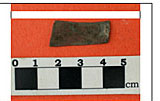 |
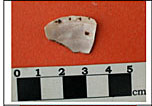 |
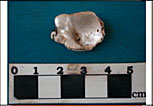 |
 |
 |
 |
 |
 |
 |
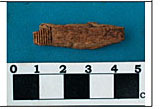 |
Many other items have been discovered that also represent the officers’ activities on the island. Highlighted here are some of the variety of buttons that we have found this year. (Click on the artifacts for larger images.)
 |
 |
 |
 |
 |
 |
 |
 |
 |
Among our findings were two hard rubber buttons made at the Novelty Rubber Company in New York. We also found what appears to be a marbleized porcelain button, as well as a brown porcelain button. One copper button, only .5 cm in diameter, is one of the smallest we have discovered. We’re not sure how this button was used.

